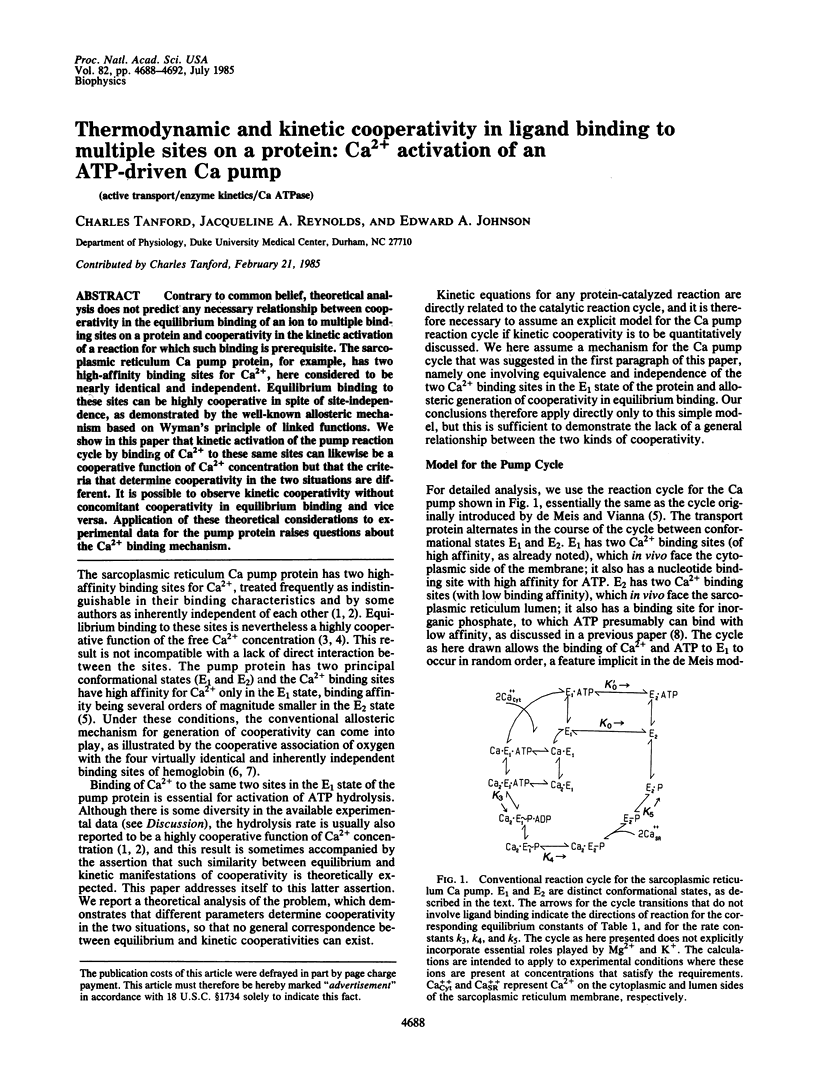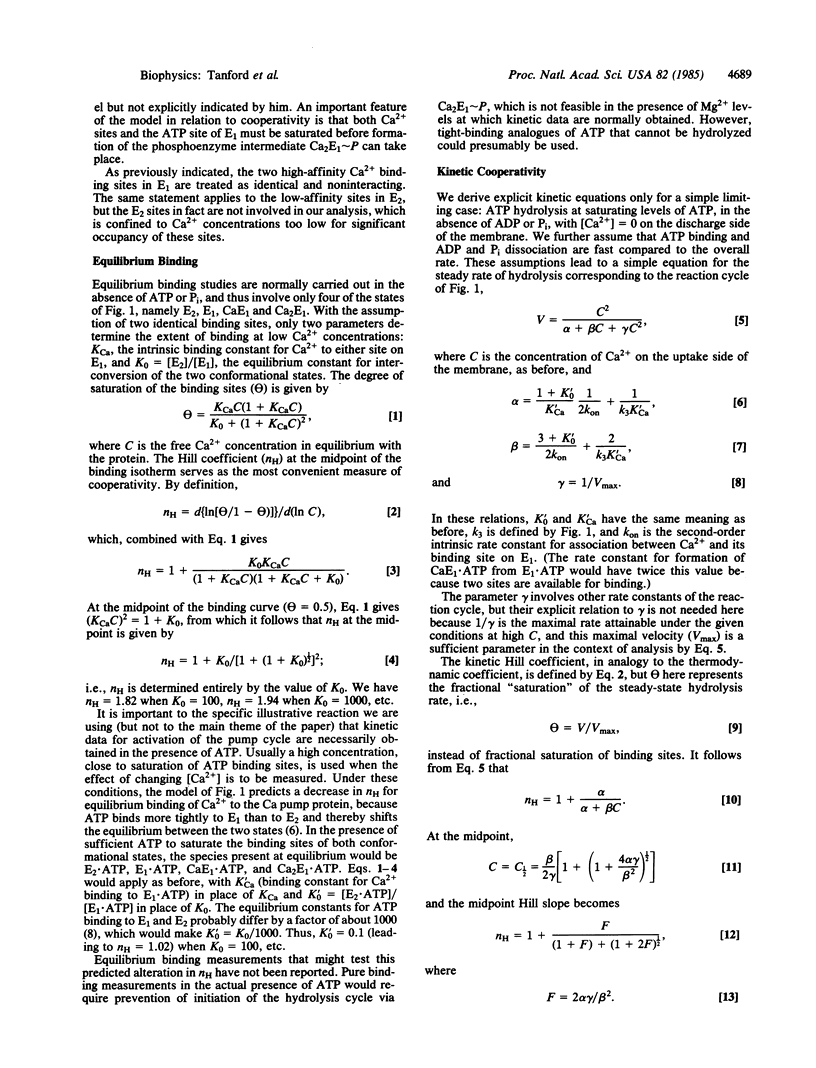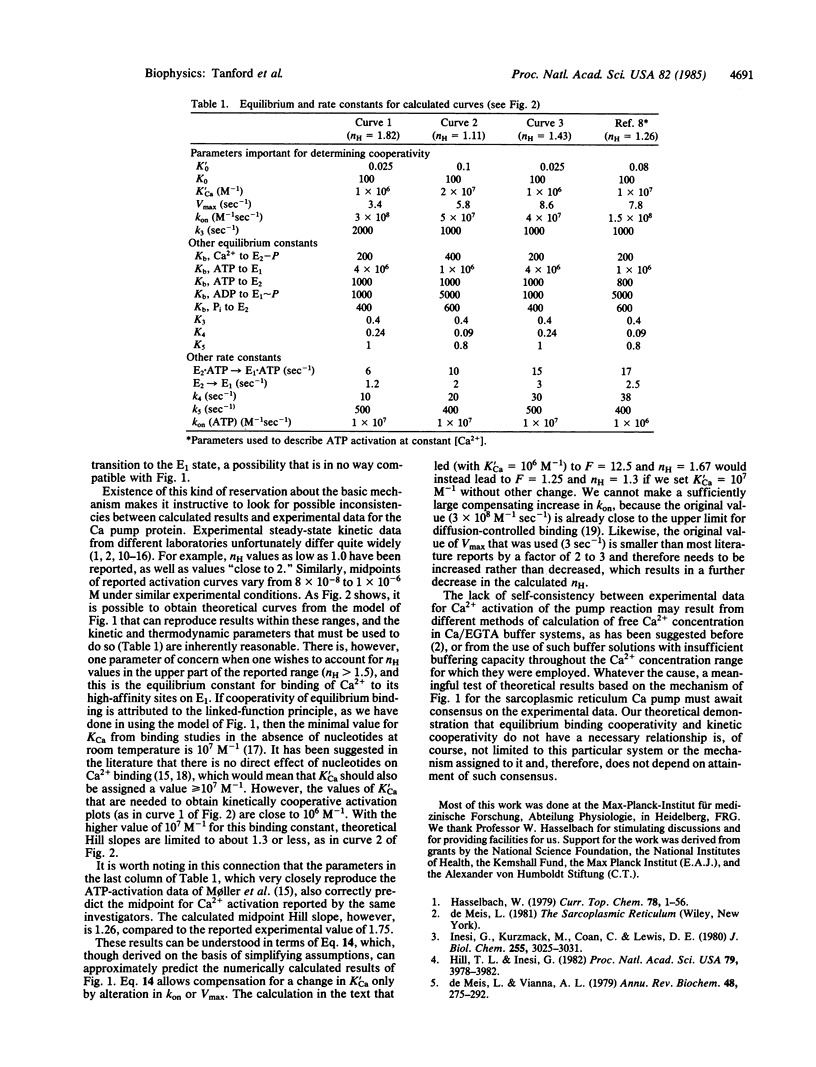Abstract
Contrary to common belief, theoretical analysis does not predict any necessary relationship between cooperativity in the equilibrium binding of an ion to multiple binding sites on a protein and cooperativity in the kinetic activation of a reaction for which such binding is prerequisite. The sarcoplasmic reticulum Ca pump protein, for example, has two high-affinity binding sites for Ca2+, here considered to be nearly identical and independent. Equilibrium binding to these sites can be highly cooperative in spite of site-independence, as demonstrated by the well-known allosteric mechanism based on Wyman's principle of linked functions. We show in this paper that kinetic activation of the pump reaction cycle by binding of Ca2+ to these same sites can likewise be a cooperative function of Ca2+ concentration but that the criteria that determine cooperativity in the two situations are different. It is possible to observe kinetic cooperativity without concomitant cooperativity in equilibrium binding and vice versa. Application of these theoretical considerations to experimental data for the pump protein raises questions about the Ca2+ binding mechanism.
Full text
PDF




Selected References
These references are in PubMed. This may not be the complete list of references from this article.
- Champeil P., Gingold M. P., Guillain F., Inesi G. Effect of magnesium on the calcium-dependent transient kinetics of sarcoplasmic reticulum ATPase, studied by stopped flow fluorescence and phosphorylation. J Biol Chem. 1983 Apr 10;258(7):4453–4458. [PubMed] [Google Scholar]
- Duggan P. F. Caclium uptake and associated adenosine triphosphatase activity in fragmented sarcoplasmic reticulum. Requirement for potassium ions. J Biol Chem. 1977 Mar 10;252(5):1620–1627. [PubMed] [Google Scholar]
- Hasselbach W. The sarcoplasmic calcium pump. A model of energy transduction in biological membranes. Top Curr Chem. 1979;78:1–56. [PubMed] [Google Scholar]
- Hill T. L., Inesi G. Equilibrium cooperative binding of calcium and protons by sarcoplasmic reticulum ATPase. Proc Natl Acad Sci U S A. 1982 Jul;79(13):3978–3982. doi: 10.1073/pnas.79.13.3978. [DOI] [PMC free article] [PubMed] [Google Scholar]
- Inesi G., Hill T. L. Calcium and proton dependence of sarcoplasmic reticulum ATPase. Biophys J. 1983 Nov;44(2):271–280. doi: 10.1016/S0006-3495(83)84299-4. [DOI] [PMC free article] [PubMed] [Google Scholar]
- Inesi G., Kurzmack M., Coan C., Lewis D. E. Cooperative calcium binding and ATPase activation in sarcoplasmic reticulum vesicles. J Biol Chem. 1980 Apr 10;255(7):3025–3031. [PubMed] [Google Scholar]
- Kanazawa T., Boyer P. D. Occurrence and characteristics of a rapid exchange of phosphate oxygens catalyzed by sarcoplasmic reticulum vesicles. J Biol Chem. 1973 May 10;248(9):3163–3172. doi: 10.2172/4473783. [DOI] [PubMed] [Google Scholar]
- MONOD J., WYMAN J., CHANGEUX J. P. ON THE NATURE OF ALLOSTERIC TRANSITIONS: A PLAUSIBLE MODEL. J Mol Biol. 1965 May;12:88–118. doi: 10.1016/s0022-2836(65)80285-6. [DOI] [PubMed] [Google Scholar]
- Makinose M. The phosphorylation of the membranal protein of the sarcoplasmic vesicles during active calcium transport. Eur J Biochem. 1969 Aug;10(1):74–82. [PubMed] [Google Scholar]
- Møller J. V., Lind K. E., Andersen J. P. Enzyme kinetics and substrate stabilization of detergent-solubilized and membraneous (Ca2+ + Mg2+)-activated ATPase from sarcoplasmic reticulum. Effect of protein-protein interactions. J Biol Chem. 1980 Mar 10;255(5):1912–1920. [PubMed] [Google Scholar]
- Pickart C. M., Jencks W. P. Energetics of the calcium-transporting ATPase. J Biol Chem. 1984 Feb 10;259(3):1629–1643. [PubMed] [Google Scholar]
- Reynolds J. A., Johnson E. A., Tanford C. Application of the principle of linked functions to ATP-driven ion pumps: kinetics of activation by ATP. Proc Natl Acad Sci U S A. 1985 Jun;82(11):3658–3661. doi: 10.1073/pnas.82.11.3658. [DOI] [PMC free article] [PubMed] [Google Scholar]
- Suko J., Hasselbach W. Characterization of cardiac sarcoplasmic reticulum ATP-ADP phosphate exchange and phosphorylation of the calcium transport adenosine triphosphatase. Eur J Biochem. 1976 Apr 15;64(1):123–130. doi: 10.1111/j.1432-1033.1976.tb10280.x. [DOI] [PubMed] [Google Scholar]
- Tanford C., Martin D. W. Equilibrium constants for some steps of the reaction cycle of the sarcoplasmic reticulum calcium pump. Z Naturforsch C. 1982 May-Jun;37(5-6):522–526. doi: 10.1515/znc-1982-5-626. [DOI] [PubMed] [Google Scholar]
- The R., Hasselbach W. Stimulatory and inhibitory effects of dimethyl sulfoxide and ethylene glycol on ATPase activity and calcium transport of sarcoplasmic membranes. Eur J Biochem. 1977 Apr 15;74(3):611–621. doi: 10.1111/j.1432-1033.1977.tb11430.x. [DOI] [PubMed] [Google Scholar]
- WYMAN J., Jr LINKED FUNCTIONS AND RECIPROCAL EFFECTS IN HEMOGLOBIN: A SECOND LOOK. Adv Protein Chem. 1964;19:223–286. doi: 10.1016/s0065-3233(08)60190-4. [DOI] [PubMed] [Google Scholar]
- de Meis L., Vianna A. L. Energy interconversion by the Ca2+-dependent ATPase of the sarcoplasmic reticulum. Annu Rev Biochem. 1979;48:275–292. doi: 10.1146/annurev.bi.48.070179.001423. [DOI] [PubMed] [Google Scholar]


